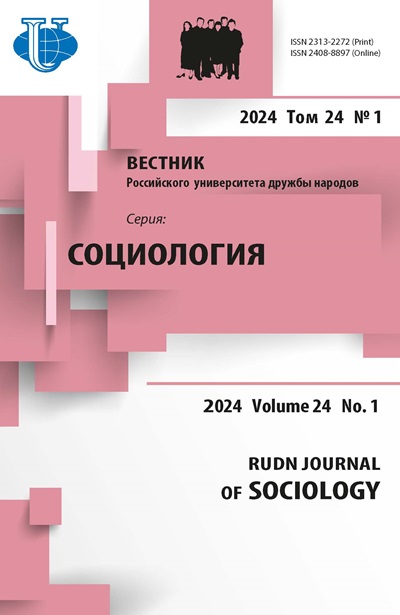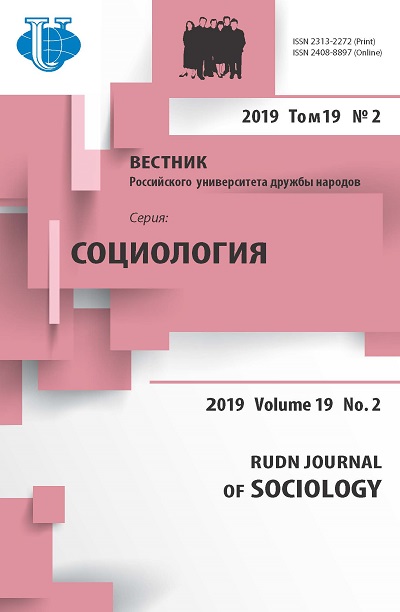Ethnic distance among the students of Serbia
- Authors: Šuvaković U1
-
Affiliations:
- University of Belgrade
- Issue: Vol 19, No 2 (2019)
- Pages: 203-211
- Section: Sociology in Serbia
- URL: https://journals.rudn.ru/sociology/article/view/21094
- DOI: https://doi.org/10.22363/2313-2272-2019-19-2-203-211
Cite item
Full Text
Abstract
Аbstract. The paper presents the results of the research aimed at identifying changes in ethnic distance among the students of Serbia. The starting point of the study was the author’s belief that ethnic distance is a good indicator of inter-ethnic relations in multi-nation society and an indicator of conflict potential, and that ethnic distance is more stable provided social stability and open society. Ethnic distance was studied in the longitude project among Serbian students at the University in Kosovska Mitrovica five times in 2009-2016, twice - among the students in Belgrade (2010, 2014), and once among the Albanian students in Priština (December 2016 - January 2017) based on the modified Bogardus scale, a part of the questionnaire in the students’ native language and a number of surveys. The paper presents the results of the measurements of values constituting ethnic distance. The data reveal that the largest ethnic distance among Serbian students in Belgrade and in Kosovska Mitrovica was with the Albanians, while the smallest ethnic distance - with the Russians and Greeks. Among the Albanian students, the largest ethnic distance was with the Serbs, Romani and Russians, while the smallest -with the Americans and English. Certainly, the explanation should take into account the relations of these nations and official policies of their states including the self-proclamation of “Kosovo independence”, and also the positions of these nations in the period of the disintegration of Yugoslavia, wars in the former Yugoslav states and the NATO aggression on Serbia. At the same time, the ethnic distances are extremely large in the territory of Kosovo and Metohija, however, with a tendency of decline among the Serbs. During the research in 2016 - the beginning of 2017, the values of ethnic distance of the Serbian students from Kosovska Mitrovica to the Albanians and of the Albanian students from Priština to the Serbs were practically the same, especially the leading values of ethnic distance. When explaining the large ethnic distance with the Romani, it is necessary to remember about their social marginalization.
Keywords
About the authors
U Šuvaković
University of Belgrade
Author for correspondence.
Email: uros.suvakovic@uf.bg.ac.rs
-
Kraljice Natalije 43, Beograd, Serbia, 11000References
- Asylum in the EU in the first quarter of 2015: 185,000 first time asylum seekers in the EU in the first quarter of 2015 - half are Kosovars, Syrians or Afghans. http://ec.europa.eu/ eurostat/documents/2995521/6887997/3-18062015-CP-EN.pdf/4457b050-26f9-4cf1-bf27-9ffb73ff8c7b 28.02.2016.
- Baćević Lj. National consciousness of the youth. Mihailović S. at al. (Eds.) Children of Crisis - Youth of Yugoslavia in the late 1980s. Beograd; 1990 (In Serbian).
- Bazić J. The role of the Kosovo myth in shaping Serbian national identity. Srpska Politička Misao. 2012; 4 (In Serbian).
- Bogardus E.S. Measurement of personal-group relations. Sociometry. 1947; 10 (4).
- Kuzmanović B. Social distance with different nations. Lazić M. (Ed.). Destruction of Society. Beograd; 1994 (In Serbian).
- Lazar Ž., Koković D. Ethnical distance in Vojvodina: Results of the research. Sociološki Pregled. 2005; 39 (3) (In Serbian).
- Mitrović A. At the Bottom: The Romani at the Risk of Poverty. Beograd; 1990 (In Serbian).
- Petrović J. On the methodology of empirical research (sample, questionnaire and field stage). Šuvaković U, Petrović J. (Eds.). Students in the North of Kosovo and Metohija. Kosovska Mitrovica; 2016 (In Serbian).
- Petrović J., Miladinović S. Profile of the ethnic distancing among students of the University of Niš. Dimitrijević B. (Ed.). Historiography and Contemporary University. Vol. 1. Niš; 2014 (In Serbian).
- Petrović J., Šuvaković U. Social distance of students from Serbia, Macedonia and Bulgaria with the Romani. Godišnjak za Sociologiju. 2016; 11 (In Serbian).
- Petrović Ј. Interethnic relations in Kosovo and Metohija studied through the ethnic distance prism. Maliković D. (Ed. in chief). Kosovo and Metohija in Civilization Processes. Vol. 4. Šuvaković U. (Ed.). Sociology and Other Social Sciences. Kosovska Mitrovica; 2010 (In Serbian).
- Popadić D. A way from fraternity and unity - ethnic distance of citizens of Serbia. Mihailović S. (Ed.). How Citizens of Serbia Define Transition: A Public Opinion Poll. Beograd; 2010 (In Serbian).
- Sotirović V.B. Kosovo & Metohija: Ten years after the ‘March Pogrom 2004’. Srpska Politička Misao. 2014; 1 (In Serbian).
- Šuvaković U. A sketch of the ethno-political views of the Serbian students in Kosovo. Sotsiologicheskie Issledovaniya. 2010; 3 (In Russ.).
- Šuvaković U. Century of separatist violence of the Kosovo Albanians against the Serbs and other citizens of non-Albanian nationality (1912-2012). Maliković D, Šuvaković U., Stevanović O. (Eds.). Political Violence. Kosovska Mitrovica; 2011 (In Serbian).
- Šuvaković U. Serbia in the Era of Changes. Moscow; 2016 (In Russ.).
- Šuvaković U., Petrović J. Attitudes to Kosovo and Metohija and estimates of the most important global goals of Serbia: Comparative analysis of the students’ attitudes in the Univeristy in Priština with temporary head office in Kosovska Mitrovica and the University of Belgrade. Zbornik Radova Filozofskog Fakulteta u Prištini. 2010; 40 (In Serbian).
- Šuvaković U., Petrović J. Ethnic distance expressed by students in northern Kosovo and Metohija in a longitudinal coparative study. Srpska Politička Misao. 2014; 4 (In Serbian).
- Šuvaković U., Stevanović O. Separatist rebellion of the Albanian students in Kosovo and Metohija in 1981 as the beginning of the socialist Yugoslavia breakdown. Sociološki Pregled. 2018; 52 (4) (In Serbian).
- Todorović D. Social Distance with the Romani. Niš; Novi Sad; 2007 (In Serbian).














